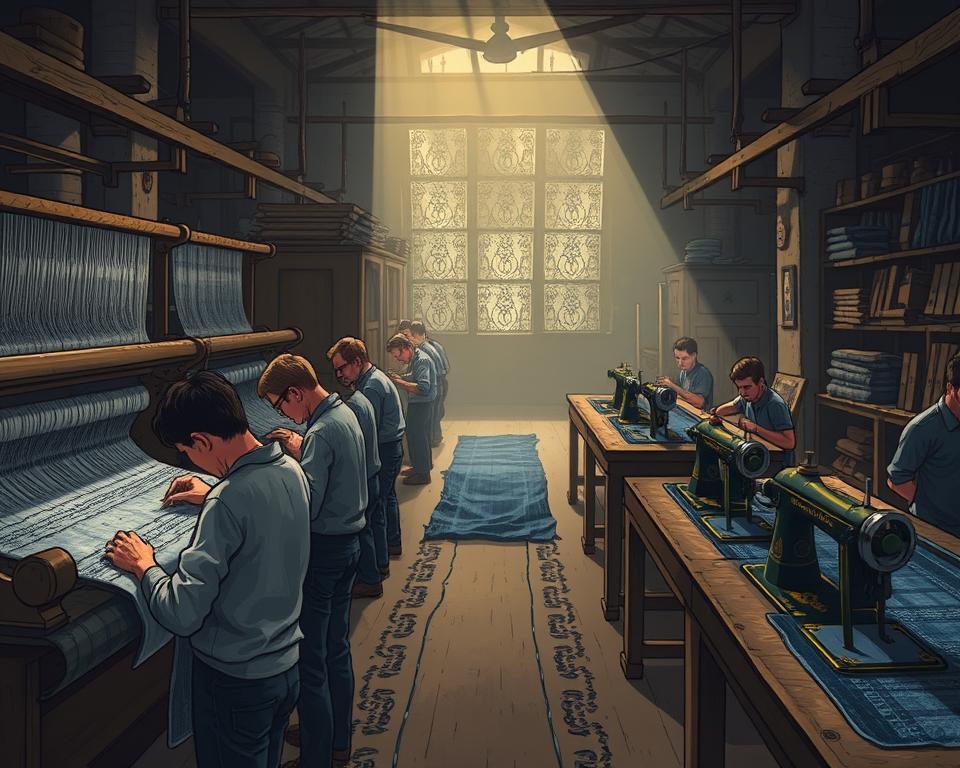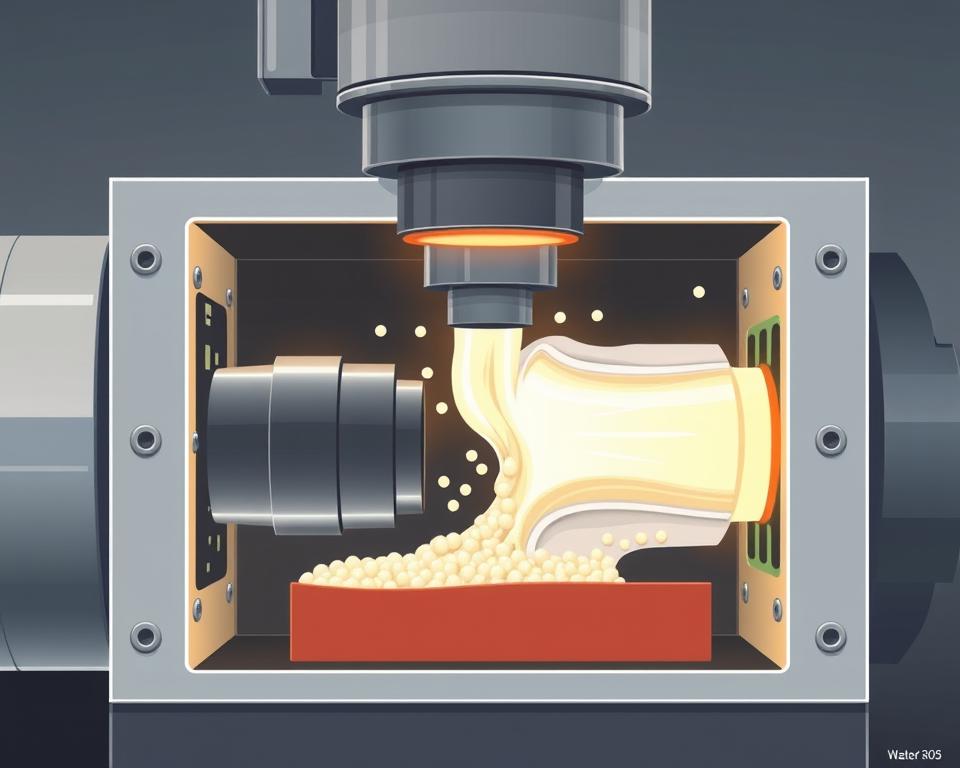Selvedge Denim Material: What You Need to Know
A single pair of vintage Levi’s 501s from the 1940s recently sold for $87,400 at auction. Why were these trousers valued higher than a high-end automobile? It all comes down to their selvedge denim fabrication.
This premium denim represents more than just fabric. It connects us to a time when James Dean wore his 501s in Rebel Without a Cause and Marlon Brando defined cool in The Wild One. Those style icons didn’t merely don jeans. They chose Nep denim woven on antique shuttle looms.
Craft denim derives its title from the self-finished perimeters that avert fraying. The word “selvedge” fuses “self” and “edge” to depict this singular weaving approach. Unlike mass-produced jeans, each yard of selvedge denim material takes time and skill to create.
The surface narrates a tale via gentle inconsistencies and organic variations. Every pair acquires character as its indigo wears down. This unique aging grants heritage denim its special appeal among collectors and fashion devotees alike.
Numerous people assume high-end denim endures beyond ordinary jeans. The reality, however, is more delicate. Selvedge build yields exquisite cloth with neat borders and deep texture. But strength depends on cotton quality and weight, not just weaving technique. What differentiates artisanal denim is its knack for aging with grace and creating singular fading designs in the long run.
What Is Selvedge Denim Material
Selvedge denim cloth stands apart from standard denim because of its special build and polished borders. It draws its name from the “self-edge,” a dense woven strip that stops fraying. This premium material embodies a dedication to slow fashion and traditional craftsmanship, setting it apart from mass-produced denim.

The Meaning Behind Self-Edge Construction
The term “selvedge” is a blend of “self” and “edge,” describing fabric with a clean, finished border. This narrow selvage forms along both fabric sides, eliminating the need for additional finishing. Heritage mills make it about 30–32 inches wide, as opposed to modern denim’s 60-inch breadth.
Why Shuttle Looms Yield Distinct Fabric Edges
Shuttle-loomed denim’s character comes from vintage weaving machines that weave at slower speeds. They shuttle one weft yarn across the warp threads in one continuous action. This approach produces:
- Natural texture variations called slubs
- A plusher hand-feel versus modern denim
- Securely finished edges that resist fraying
- Real irregular traits loved by denim aficionados
How Selvedge Differs from Standard Denim
Regular denim comes from projectile looms firing weft yarns over broader widths. That technique produces loose edge threads that must be overlocked to avoid fraying. Selvedge denim fabric, however, requires extra time in production. It offers superior durability and a unique aesthetic, justifying its higher cost.
The Heritage and History of Shuttle-Loomed Denim
The legacy of heritage denim commenced in U.S. textile mills of the 1800s. Shuttle looms played a vital role, crafting cloth with self-finished edges to stop fraying. That approach yielded indigo-dyed denim slowly and painstakingly, guaranteeing each yard was made with precision. The narrow width of this fabric became a hallmark of artisanal denim production.
From 1800s American Mills to Modern Revival
For over a century, American mills relied on shuttle looms. Names such as Cone Mills and White Oak furnished top denim to workwear makers. Come the 1970s, speedier projectile looms dominated, supplanting most shuttle setups. This shift was driven by the need for cheaper, mass-produced jeans. Many historic mills closed or modernized, leaving vintage looms to gather dust.
Japanese Renaissance of Selvedge Denim
In the 1980s, Japanese producers brought American shuttle looms back into use. Leading the charge were the Osaka Five brands:
- Studio D’Artisan
- Evisu
- Fullcount
- Warehouse
- Denime
These companies merged American vintage style with Japanese precision. They studied old Levi’s patterns, recreating classic indigo-dyed denim textures. By 2000, Japanese makers had overtaken the global artisan denim market.
The Importance of Traditional Weaving Today
Shuttle looms create special fabric features unmatched by modern equipment. The slower weaving process allows for irregular textures and deeper indigo penetration. Denim aficionados prize these flaws as hallmarks of genuine artistry.
| Shuttle Loom Features | Modern Loom Features |
|---|---|
| 29-31 inch fabric width | 60+ inch fabric width |
| 3-4 yards per hour | 15-20 yards per hour |
| Natural irregularities | Uniform texture |
| Self-finished edges | Cut edges requiring overlocking |
Making Premium Denim on Antique Looms
The creation of premium denim starts with the rhythmic motion of vintage shuttle looms. These contraptions stand apart from modern machines. They pass yarn across the entire width in one thread, sealing edges without extra finishing. This approach guarantees selvedge denim sports a neat, fray-free border.
Old shuttle looms turn out a mere 5 to 6 meters of selvedge denim material each day. This sharply contrasts with current machines that manage 200 meters. Slow operation enhances the yarn by:
- Reduced fiber tension yields a gentler feel
- Inherent slubs persist, offering a one-of-a-kind texture
- Irregular topography crafts unique fade patterns
- Thin widths (about 29–32 inches) minimize trimming waste
Operating these antique machines requires skilled craftsmen. Operators fine-tune tension, track cadence, and carry out maintenance. Each shuttle loom carries its own character. Many were built in the 1920s and require know-how passed through the ages. This tactile method turns shuttle-loomed denim into an authentic artisan good.
The slender width of unwashed denim from classic looms provides practical perks. Jean makers can use the self-finished edge as the outseam, eliminating waste. This flaunts the cloth’s true craftsmanship. Every bolt carries history, with slight quirks that mass output cannot match.
Differentiating Raw Denim from Selvedge Denim
Numerous denim lovers conflate raw denim with selvedge denim. This mix-up appears during premium jean hunts. The truth is, these terms describe different aspects of denim production. Knowing the difference helps you make better choices and appreciate each type’s uniqueness.
Why Not All Selvedge Is Raw
Selvedge denotes the shuttle-loom weaving style that yields self-finished edges. Raw denim means unwashed fabric straight from the mill. A selvedge raw denim supplier may stock washed and unwashed varieties. Companies like Naked & Famous craft selvedge jeans, sometimes pre-washed or stretch-infused.
The loom process stays constant. But finishing alters the material’s hand-feel and aesthetic completely.
Choosing Between Washed and Unwashed Denim
All denim starts as dry denim prior to wash. Weavers ship both standard and selvedge bolts unwashed. The principal distinctions are:
- Raw denim evolves custom fade patterns via use
- Pre-washed denim offers instant comfort and stable sizing
- Sanforized raw stays closer to original measurements after first wash
- Unsanforized versions shrink significantly when soaked
Debunking Common Denim Misunderstandings
Not every raw denim is shuttle-loom produced. Modern projectile looms also produce unwashed fabric. Their appeal converges since consumers prize longevity, customization, and artistry in both selvedge and raw denim. Each style lures denim aficionados ready to devote time for bespoke fades.
Spotting Genuine Selvedge Denim Traits
When hunting for herringbone selvedge denim fabric, identifying authentic selvedge denim is crucial. It separates you from everyday customers. Genuine selvedge denim boasts characteristics missing in standard denim. Understanding these features ensures you’re investing in authentic premium denim.
Spotting the Signature Selvedge ID
The simplest way to identify selvedge denim is by checking the outseam. Cuff your jeans and check the outer-leg seam. Real selvedge denim shows a neat, sealed edge with dyed yarns interwoven. Its self-finished perimeter does away with overlock seams used in ordinary denim.
Rolling your cuffs unveils the selvedge ID, giving your outfit a signature detail. The tinted edge threads flow uninterrupted along the outseam, crafting that iconic denim aesthetic fans love. Non-selvedge jeans, on the other hand, have cut edges covered with serger stitching to prevent fraying.
Recognizing Quality Construction Details
High-grade premium denim shows distinct assembly details:
- Compact, consistent weave without loose fibers
- Pristine selvedge ends with no added stitching
- Consistent colored yarn throughout the outseam
- Dense fabric weight typical of shuttle-loom production
Why Rainbow and Redline Selvedge Are Unique
Rainbow selvedge uses multiple tinted yarns in the ID, crafting a distinct multicolor trim. Redline selvedge, the most famous variety, uses red yarns for the ID and traces back to vintage American mills. These distinctive selvedge variants fetch more owing to their rarity and visual charm. Brands often showcase these details in listings, aiding you in spotting genuine heritage denim.
What Drives Artisanal Denim Prices
Newcomers are often astonished by artisanal denim price tags. A set of selvedge jeans may run three to five times higher than standard jeans.
Comprehending what drives these costs shows the actual value of premium denim.
Shuttle looms run far more slowly than contemporary looms. Though factory looms crank out fabric fast, old shuttle looms manage only 1–2 meters hourly. This slow process means a single roll of heritage denim takes days, not hours.
The slender breadth of selvedge fabric hikes up costs. Whereas conventional denim comes 60 inches wide, shuttle-loomed premium denim measures only 28–32 inches. This restricted width entails meticulous layout and cutting to minimize waste.
Craft denim making happens in small runs. Mills like Okayama’s White Oak and Kuroki prioritize quality over quantity. They employ master craftsmen who oversee every step:
- Hand-checking yarn tension
- Adjusting loom settings for each fabric type
- Inspecting every meter for flaws
- Managing rope-dyeing processes that take weeks
These artisans treat denim-making like fine art. They play with distinct yarns and hone indigo-dye recipes handed down through the lineage. Backing heritage denim helps mills safeguard textile legacies and artisans devoted to their work.
Wholesale Choices for Black Selvedge Denim Fabric
The premium denim market has grown beyond Japan’s traditional mills. American manufacturers now challenge, supplying multiple black selvedge denim wholesale options. To find the best supplier, it’s essential to understand quality markers and the origins of authentic materials.
Finding Quality Suppliers and Manufacturers
Top vendors underscore traditional weaving and genuine devotion to craft. When seeking a selvedge raw denim wholesale source, pick mills operating antique shuttle looms. They list full specs: fabric heft, weave design, and dye techniques.
Gold Selvedge Denim Fabric Manufacturers to Know
Gold selvedge denim fabric manufacturers focus on premium colored ID lines, adding luxury to jeans. Top factories craft these niche fabrics in small batches, drawing boutique labels. The gold-ID thread bestows an exclusive trim, differentiating them from usual choices.
How to Procure Nep Denim and Unique Weaves
Special weaves like nep denim warrant direct sourcing links. Nep denim boasts purposeful slubs for eye-catching texture. Directly working with mills ensures access to these specialized weaves.
| Fabric Type | Minimum Order | Lead Time | Price Range per Yard |
|---|---|---|---|
| Black Selvedge | 500 yards | 6-8 weeks | $12-18 |
| Gold ID Selvedge | 300 yards | 8-10 weeks | $15-22 |
| Nep Denim | 400 yards | 10-12 weeks | $14-20 |
Popular Selvedge Styles and Fabric Variations
Selvedge denim circles stretch beyond simple indigo. Currently, manufacturers produce varied textures and designs. They highlight the adaptability of shuttle-loom craftsmanship. Ranging from faint surface quirks to striking patterns, they deliver one-of-a-kind personality that evolves elegantly with use.
All About Slub Denim Texture
Slub denim’s distinctive bumpy texture comes from irregular yarns. They feature thick and thin zones, yielding an organically varied fabric face. When shuttle looms weave these yarns, they produce a textured selvedge denim fabric that fades in unpredictable ways.
Each slub denim jean yields its own one-off wear pattern. The raised slubs fade differently than the flat parts, ensuring no two pairs look alike.
Herringbone Selvedge Denim Fabric Characteristics
Herringbone selvedge cloth sports a zigzag weave reminiscent of fish skeletons. It yields slanted lines alternating direction at consistent spaces. This motif boosts aesthetics and reinforces the cloth’s durability.
Labels such as Iron Heart and The Strike Gold often employ this weave in their high-end lines.
Striped Denim Fabric and Unique Weaves
Striped denim uses alternating threads to form vertical or horizontal stripes. Workrooms produce these stripes by alternating colored yarns in the weave. Notable variants include:
- Hickory stripe with alternating indigo and white
- Railroad stripe featuring thin pinstripes
- Wabash stripe with printed dots over stripes
| Fabric Type | Visual Pattern | Fade Characteristics |
|---|---|---|
| Slub Denim | Bumpy, irregular surface | High contrast, uneven fading |
| Herringbone | Zigzag diagonal lines | Subtle vertical streaking |
| Striped Denim | Alternating color bands | Pattern remains visible after fading |
Care Tips for Your Heritage Denim
Heritage denim needs particular attention to evolve its distinct personality. Unlike regular jeans, raw denim and dry denim transform with wear. They create personalized fade patterns that tell your story.
Your first few wears in artisan denim might feel firm and odd. This experience is expected. The material requires wear to relax and hug your silhouette. Some wearers hasten the softening by donning them in the shower or squatting when damp. Others prefer a slower, more natural break-in period.
Raw denim shows top fade patterns when you postpone laundering. Natural skin oils and daily movement produce whiskers at knees and honeycombs on the back. Many owners go six months before their first wash, while some wait a full year. This discipline grants you dramatic, bespoke fades reflecting your motions.
At wash time for dry denim, invert and launder in cold water. Forego spin and drip-dry in shade. Others opt for gentle hand-wash in a bathtub using a soft detergent. Steer clear of hot water and tumble drying, which may shrink and dull fades.
Your heritage denim investment grows more valuable with proper care. Each use builds character, turning your jeans into a singular piece. The stiff beginning morphs into a snug second skin echoing your habits.
Where to Buy Quality Indigo-Dyed Denim Today
The revival of selvedge denim has unlocked new paths for denim lovers. Large chains now offer indigo denim, while niche shops continue premium slow-fashion offerings. This allows consumers to find authentic selvedge options at various price points, catering to different budgets and styles.
Levi’s retails the 501 Original Fit Selvedge at $148, spreading heritage craftsmanship further. Uniqlo offers its Selvedge Straight at $50, striking a balance between style and price. If you want luxury, Buck Mason stocks Japanese Loom State Selvedge Full-Saddle Jeans for $248. Iron Heart pushes premium denim further with its 634s-18 Vintage Denim Jeans at $385 via Self Edge.
U.S. labels such as Todd Snyder and Buck Mason now rival Japanese experts in the selvedge arena. They understand that heritage weaving and top quality drive slow fashion. Online or offline, good indigo-dyed denim is easier than ever for American shoppers devoted to genuine craft.


